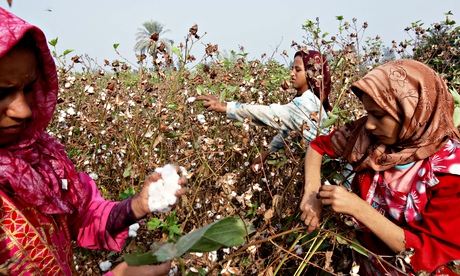
It is the pride of linen departments around the world. Yet depending on who you believe, the days of Egyptian cotton – the source of what some see as the softest and most durable bedsheets on the market – may be numbered.
According to farmers in Egypt, the government’s recent decision to end subsidies for cotton growers sounded the death knell for an already declining industry. They say the subsidy was the difference between breaking even and making a loss.
“The margin is very low and, with no subsidy, I think that no farmer will grow cotton any more,” said Gamal Siam, a cotton farmer, agricultural economist at Cairo University and former adviser to Egypt’s agriculture ministry. “This is the end of Egyptian cotton.”
Farmers of Egypt’s 300,000 feddans (126,000 hectares) of cotton make about 6,000EGP (£550) per feddan. Most of that goes on labour and other costs, meaning the aid, worth 1,400EGP per feddan, is what keeps farmers afloat. “They are actually having problems even with the subsidy,” said Osama al-Khouli, co-founder of Egypt’s independent farmers’ union. “What will happen when they remove it?”
Since the early 90s, when the government finally allowed the price of Egyptian cotton to be dictated by global markets, the sector has been in slow decline. Two decades ago, Egyptian growers produced up to 400,000 tonnes of cotton lint; last year, that figure had dropped to 127,000, according to Terry Townsend, former executive director of the International Cotton Advisory Committee, an intra-governmental body. “By 2020, my forecasts are that Egypt will be producing 60,000 tonnes,” he said. “It’s not going to be zero, but Egypt is a very urban country, and cotton is just not the best use of its land. Other crops have a better economic return than cotton does.”
Farmers such as Khouli have given up cotton growing, while Siam said the removal of this year’s subsidy was the last straw for him. “Myself, I’ve decided not to grow Egyptian cotton any more,” he said. “It’s just wasting time and resources.”
The government feels there is little point in propping up cotton producers at a time when the state is short of money. The global cotton price is low and Egyptian cotton mills mainly process foreign cotton fibres, which are shorter and easier to work with than the fabled local long ones.
For Siam, the loss of a crop that is synonymous with his country, and which all farmers were once legally obliged to grow, is cause for sorrow: “It’s a valuable thing for me and my culture. “It’s very famous, everywhere I go in the world, everyone knows Egyptian cotton, and everyone wants something made from it.”
Some in the export sector say the crisis is overblown. Ahmed el-Bosaty, president of the Alexandria Cotton Exporters Association, pointed out that the subsidy was a recent introduction anyway. There was still a chance, he said, that financial incentives would be given later in the year to mills to encourage them to buy more local cotton.“I think this has really got out of proportion,” said Bosaty, who also heads Modern Nile, one of Egypt’s biggest cotton export firms.
“The default is that there is not a subsidy [to farmers].”Officials at the agriculture ministry did not respond to requests to clarify the issue.
British homeware stores were reluctant to be drawn on what all this means for their linen stocks. But there is no cause for panic, says Townsend, the former ICAC director.
For a start, Townsend thinks Egypt’s own cotton production will not disappear entirely. Even if it did, it would be still two years before UK felt the effects – cotton picked in late 2014 will not arrive in sheet-form on the British high street until late 2016. In any case, Egypt only provides about a sixth of the world’s high-quality, long-staple cotton.
Countries including the US, India, Peru and Sudan all grow the same kind of cotton, and could pick up the slack if there was demand to do so. They would also be legally entitled to call it Egyptian cotton, said Townsend: in the 1920s, Egypt did not defend its copyright to the term. “So courts around the world ruled that ‘Egyptian cotton’ had become a generic term that referred to any cotton in this long fine form.”
But back in Egypt, none of this is much consolation for the likes of Gamal Siam. “I feel very sad,” he said. “Egyptian cotton has cultural importance. They used to call it the fourth pyramid.”
Additional reporting by Manu Abdo

